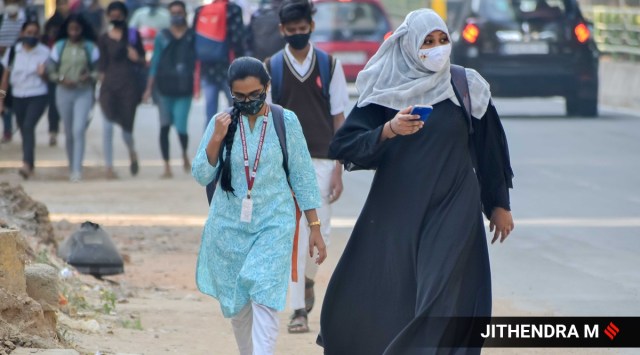
What began as a quest to re-establish the fundamental and constitutional right to religious freedom by a group of young Muslim women in Karnataka is now being heard in the Supreme Court. As a hijab-wearing Muslim woman with a keen interest in tracing the arduous journey of Muslim women into the realm of Indian higher education, a few thoughts come to mind: Did it have to come to this? It is now being asked whether the right to wear the hijab could lead down the inevitable slippery slope, to the right to undress — the latter being an unimaginable reality in schools that are in themselves arenas of immense sartorial, emotional, physical and intellectual control. The merest demand for the reasonable accommodation of the physical manifestation of one’s religious beliefs now finds itself in the long-running, exhaustive and myriad routes of interpretation of (religious) doctrine by (secular) courts, all seemingly heading nowhere. At the heart of this story are the young Muslim girls of Udupi and Dakshina Kannada, many of whom have transferred to other schools where they have the right to wear their headscarves; others are too financially fragile to be able to afford the outrageous fees of private schooling and some others are still fighting the good fight in the courts. Many have lost their friends, having been alienated and seen as trouble-makers or as having disturbed the peace.
A frequent refrain that one hears in India is, “I have full faith in the judiciary (and by extension, the law).” You hear it the most from the most marginalised in society, who have no choice but to put their faith in the only institution that is still seen as relatively untarnished by the machinations of power and political privilege. But it is also a genuine faith, not mere compulsion. There are also double standards on who can ask questions or point out failings of the courts — when the Supreme Court pulled up Nupur Sharma for her comments, right-wing commentators and anonymous accounts trended #ShariaCourtofIndia and continue to do so when certain judgements are seen favouring religious minorities. The recent remission of the murder-rape accused in the Bilkis Bano case has added another chapter to the social life of this refrain. Earlier this year, when Bilkis was awarded compensation, it was seen as a landmark judgement, a moment where justice had truly manifested in concrete terms, firmly, better late than never. The recent remission has left her vulnerable, has led to Muslims leaving the area in fear, and given an added impunity to the worst kind of offenders in Indian society.
Yet, in the absence of many other functioning democratic systems, the most marginalised — Dalits, Muslims and other oppressed communities of the country — have consistently taken their fight for survival to the realm of the law courts, despite knowing the complex realities of judicial pendency and the uncertainties of ever seeing success. They are weary of street protests and the consequent arrests and reprisals, and despite fresh memories of the death of undertrials like Stan Swamy or acquittals of innocent youths after lost decades, the courts remain the last dignified option in the increasingly deteriorated atmosphere of communalisation and entrenched caste violence.
The increasing juridicialisation of politics has, however, been a double-edged sword. Many cases languish in court, including key constitutional challenges such as the ones to the NRC and CAA. Judicial pendency aside, legal challenges often come with a sense of all or nothing — with doors being firmly closed in case of failure, such as the recent dismissal of all petitions in the Babri demolition and Gujarat 2002 cases, now rendered infructuous. Taking the judicial route itself can be immensely dangerous for vulnerable petitioners.
In this atmosphere, one can only hope that the Supreme Court of India will treat the hijab case as a moment to not interpret religious scripture, equate the girls’ demands to slippery-slope arguments, or dismiss their pleas in the face of the alleged supremacy of uniforms, uniformity and school discipline. We can only hope that it will return its focus on the travails and unyielding faith of the students at the centre of this struggle and make this case an example to reverse the losses in the doctrine of religious freedom, which has been eroded by successive governments at both the Centre and state.
The writer is a PhD researcher at the Centre for the Study of Law and Governance, JNU and a sub editor at Aura e-Magazine, a monthly women’s magazine.